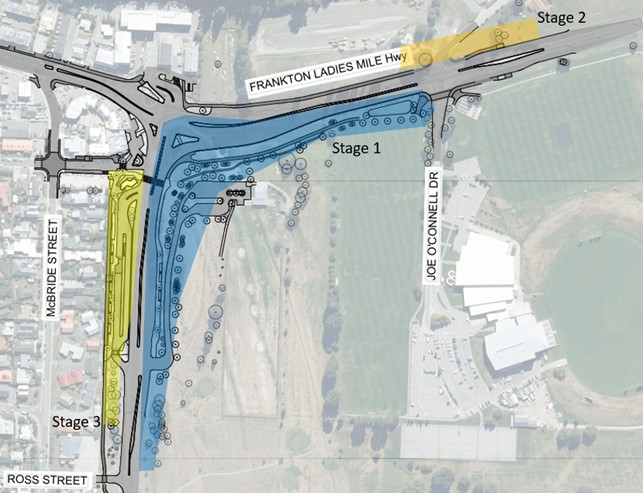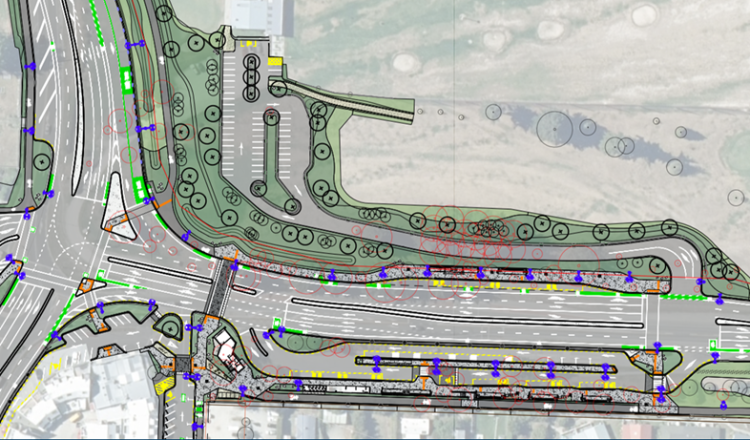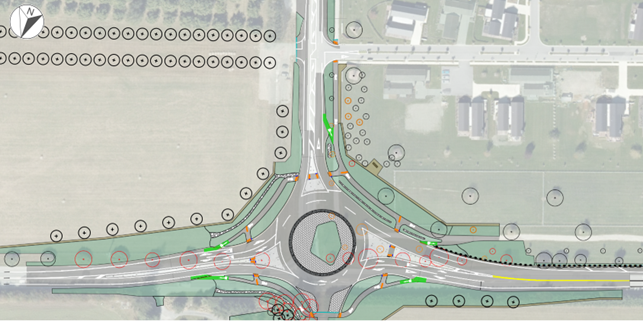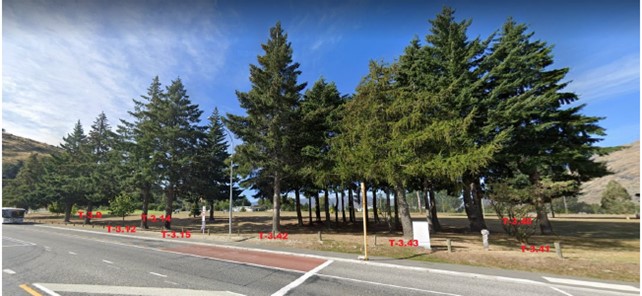We know that trees are an important part of every community and acknowledge that the scale of tree removal required to make these improvements is significant. While it is always a difficult decision to remove trees, it needs to be balanced with the need to provide better options for people to get around the growing area.
124 trees will be removed to create the new entrance and carpark for the golf course and to extend the Bus Hub. 36 trees will be removed as part of the proposed roundabout at Howards Drive.
The trees are made up of a range of species of varying condition. You can read more detail on this in the Arborist’s Report.
Trees will only be removed when it is absolutely necessary.
Removing the trees will allow us to:
- Undertake deep trenching for power and fibre to be moved from under the road and across to the golf course side of SH6. A large trench for a 1.4m diameter stormwater pipe will run from close to the airport runway up to the SH6/6A corner.
- Make room for additional bus stops.
- Make the golf course entrance safer.
- Make room for a shared use path that is off the road for less confident cyclists and linked to the Bus Hub and the local shops and businesses.
Once the construction is complete, new landscaping and replacement tree planting will occur at the new intersections and a new landscaped bund (mound) beside the golf course along the Frankton-Ladies-Mile Highway. For any trees removed on council property, NZTA will plant two replacements in an agreed location. This is in line with the Queenstown Lakes District Council Tree Policy 2022.
Queenstown Lakes District Council Tree Policy 2022(external link)
NZTA is working with QLDC to consider and identify locations for further replacement trees to be planted where these cannot be provided for as part of the proposed landscaping for the new SH6/ 6A intersection and Bus Hub. NZTA will also engage with the Lake Hayes and Shotover Country Community Association to consider replanting options for trees removed as part of the proposed Howards Drive roundabout works.
The first stage of tree removal involves removing trees on the golf course side of SH6. This will start in early April 2024, and is expected to take 1-2 weeks.

Map showing staged tree removals.
The application for tree removal has been approved by QLDC. The Landscape Mitigation Plan for the project specifies that for every one tree removed from QLDC property, two will be planted over the course of the project.
The arborist is Tree Care Southern Lakes Ltd. They are engaged by Kā Huanui A Tāhuna Alliance.
Public consultation occurred through the publicly notified NZUP Alteration to Designation process in 2023 and QLDC’s special public consultative process for the disposal of the golf course land in June / July 2022.
Kā Huanui A Tāhuna have provided a Landscape Mitigation Plan which shows how it conforms with the QLDC Tree Policy 2022. The Detailed Landscape Plan (Appendix C) shows that for every one tree removed from QLDC property, two will be planted. The majority of them will be planted within the project boundary, with the remainder planted in nearby parkland.
Appendix C - Detailed Landscape Plan [PDF, 16 MB]

Trees to be removed in red for SH6/6A Frankton Intersection and Bus Hub Improvements.
124 trees will be removed from the golf course and Bus Hub area as part of the Frankton Intersection and Bus Hub Improvements. Approximately 40 existing trees will remain
Only the trees on the Frankton Golf Centre side are being removed in 2024. Trees on the Bus Hub side will be removed closer to the time of Bus Hub construction.

Trees to be removed in red for the Howards Drive roundabout construction.
Existing trees are not being removed to improve sight lines. That is an invalid reason for tree removal under the QLDC tree policy.
The prominent tree species along the eastern side of the corridor (golf course side) are Douglas Fir, European Larch, and Cypress, noting these are wilding species. Their condition has been assessed by an independent arborist as “G” good or “F” for fair. The arborist report notes that while these species were appropriate for the site at the time of planting, attitudes have significantly changed against wilding pine species to favour native species that don’t contribute to further seed dispersal and wilding tree problems.

Fir, larch and cypress trees identified for removal to allow for an extended Bus Hub, large stormwater pipe and new entrance to the Frankton Golf Centre.
A qualified aviarist will check whether there are any nesting birds in the trees to be removed, and if there are, ensure they are moved beforehand.
Tree felling will take approximately 1 hour across three mornings. For felling we will stop traffic on SH6 from 5am to 6am. We will then be chipping from 7am as that is the noisiest part of the operation.
An excavator and chainsaw will be used together to guide trees to fall the correct way to the ground.
Health of remaining and newly planted trees
Remaining trees will be protected during construction with 1.8m construction fencing around trunks, branches and drip lines. They will be integrated into the completed landscape design. The completed landscape on the Frankton Golf Centre will be cared for in future by QLDC. The completed landscape around the main Bus Hub will be maintained by QLDC.
All tree removals comply with QLDC’s tree policy. None of the trees are being removed for the noted unaccepted reasons such as minimising the obstruction of views, or commercial signage, or to reduce leaf litter and shading.
Replanting trees
Most replacement trees will be natives. Replacement trees will be planted over four stages. As each stage of work is completed, the landscaping which includes planting will also be completed.
Species to be planted include:
- Grove trees (Mountain Beech, Lacebark, Lancewood, and Totara)
- Specimen trees (European Beech, Ribbonwood, Kowhai, Pin Oak, and three variants of Elm)
- Shrubs (Dwarf Toetoe, Tussock, Coprosma, Corokia, Manuka, Dwarf Flax, Pittosporum, Manuka, Muehlenbeckia, Tree Daisy, Ake Ake and Swarf Mountain Flax)
- A variety of sedges and tussocks
The trees will be bought in 2024 to ensure they develop sufficiently and give them the best survival rates.